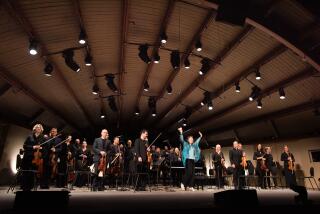Perahia’s ‘Moonlight’ Casts a Spell of Imagination
- Share via
Listening to Murray Perahia’s extraordinary performance of the “Moonlight” Sonata on Thursday night in UCLA’s Royce Hall, I began to see things. This is not my usual response to music. Seeing things in Beethoven is suspect, and no more so than in his most famous sonata. Years after it was written, the unconventionally quiet first movement inspired in an obscure German poet a vision of dreamy moonshine reflected on dappled lake, and we have been shackled with that kitschy image ever since.
For me, there was nothing as specific as a picture of nature. Instead, each note seemed a perfectly rounded physical object produced by the fingers of a meticulous pianist. Every tone had its own body and weight. The left hand triplets, fragile and barely audible, were as fine bubbles that floated in air. The dotted notes of the somber melody in the right hand also floated, but they were, by comparison, much more solid and sculptural, say shiny metallic balloons. In the furious last movement, notes again poured forth as matter, this time strings of pearls, floods of ball bearings, volleys of bullets.
A quarter century ago, Perahia built his reputation as a Mozart pianist of great, if finicky, refinement and, above all, as a pianist particularly congenial to the recording studio. Lately he has been recording Bach’s English Suites, and the first volume just won a Grammy for playing of elegant poise and luminous purity. But when he began Thursday’s recital with Fifth English Suite, which is on a new CD, the impression was very different from the alluring preciousness of recordings. Beauty was not lacking, but the level of tension was greater, the tone more penetrating, the playing more aggressively mesmerizing.
In fact, this is Perahia’s fascinating peculiarity. He is a pianist of obsessive control who concentrates on standard classical repertory, but who manages to remain surprising nonetheless. Some of the fascination is purely technical. The recital offered stunning pianism. No matter how thick the texture becomes nor how fast he plays (and sometimes he plays with breathtaking speed), Perahia seems to have weighted the balances perfectly. Everywhere he finds individual nuance. In the “Moonlight” and an earlier Beethoven Sonata, Opus 10, No. 2, a middle voice might emerge with startling prominence, yet the sense of form and direction are so secure that it all seems a miraculous sleight of hand.
But under all the control, there is, in Perahia, a certain and possibly barely controllable fury. That fury remained mostly under control in the Bach and Beethoven--even during the frenzied, crowd-wowing finale of the “Moonlight”--of the first half of the program. Schubert’s C-Minor Sonata, after intermission, was another matter. In his late piano music, Schubert balanced the serene with the manic in a disturbing yet elevating way no other composer of piano has ever quite matched. And Perahia, who viewed this troubling sonata from both extremes, could not, for all his rhythmic security and all the pearly roundness of his tone, remain cool. There was simply too much sudden, disorienting ferocity in the music and too much virtuosity in his fingers. The result was diabolical, sweetness interrupted by madness, and the two ultimately interchangeable.
After that came three encores, including a thunderous, shattering performance of Liszt’s arrangement of Schubert’s song, the “Erl King,” in which madness now seemed fully unleashed. Another Liszt / Schubert arrangement and a Schubert Impromptu quieted down emotions only somewhat and left Perahia looking as utterly spent as a listener felt. Perhaps this remarkable pianist is under the spell of moonlight after all.
More to Read
The biggest entertainment stories
Get our big stories about Hollywood, film, television, music, arts, culture and more right in your inbox as soon as they publish.
You may occasionally receive promotional content from the Los Angeles Times.











